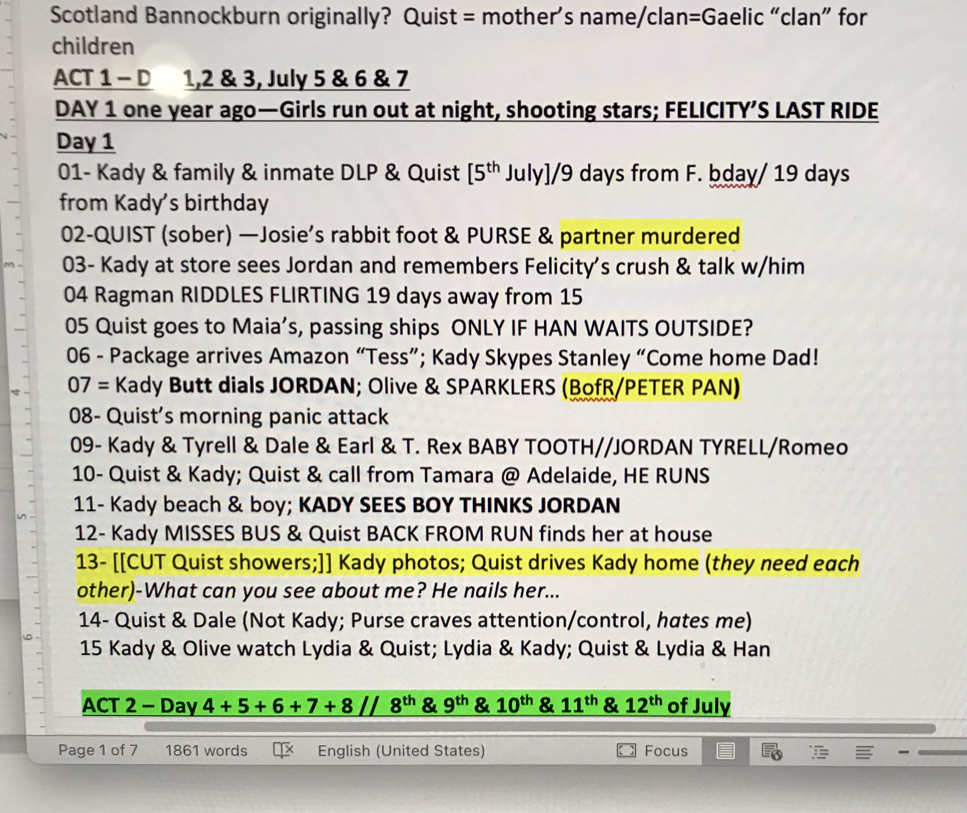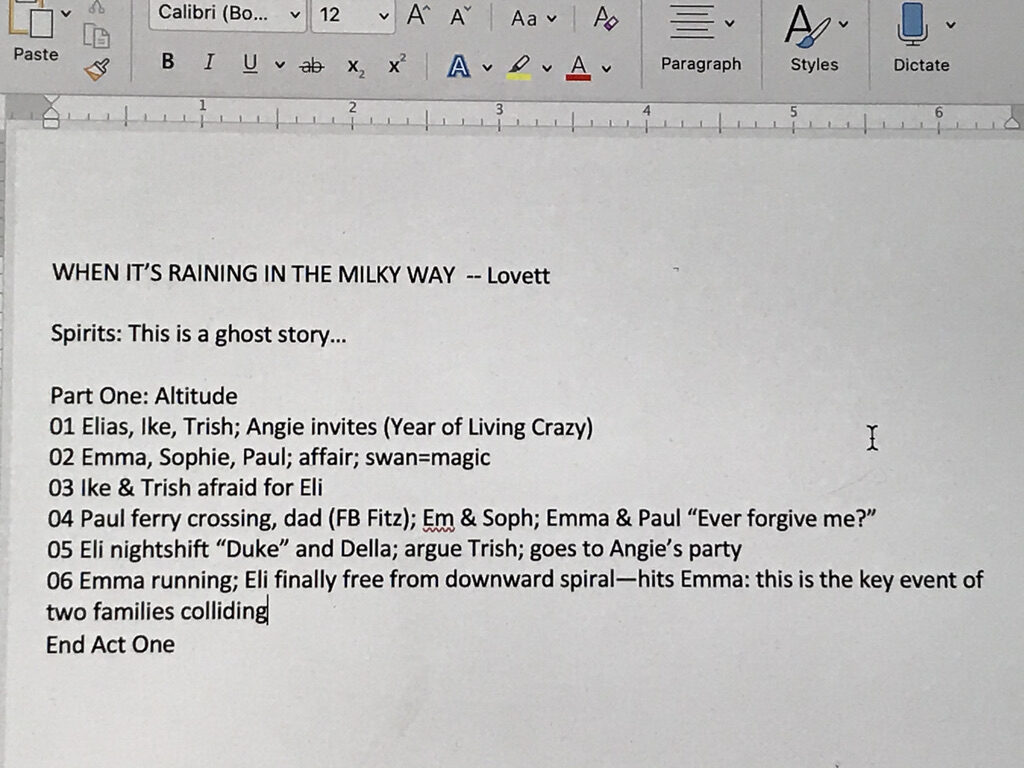Not your grandmother’s outline
Today’s post focuses on what I call the action-tracking outline, an outlining/tracking tool that might change the way you think about the “O” word. I’ve published seven novels with the big houses and I’m the author of two upcoming novels in their final stages of revision and polish–and this tool is one of the best in my writer’s toolbox.

Yes, I’m talking the “O” word
We’ve all heard the debate about ‘pantzers’ and ‘outliners’ and you can find many wise bloggers waxing on pros and cons of one or the other or both. That’s not what I’m writing about here. I’m sharing two partial examples of my action-tracking outlines because this tool is invaluable to me at various stages of my writing process. The key: when it comes to “O” for organizing and “O” for organic and “O” for “Oh, yep, here’s my entire narrative fitting on one or two pages!” my go-to is the action-tracking Outline.
Action is key
When putting together your action-tracking outline, hold one question at the front of your mind: What is my protagonist doing to get what she wants? The answers will be found in the decisions she makes (internal action) and the steps she takes (external action) to move toward her goal. [Note: For more on getting clear on your characters’ wants and needs, you might want to read my post: “Your Characters’ Desires Drive Your Story.“]

When I use my action-tracking outline
Back to the “pantzers” v “outliners” question, for the record, I do not start with a set outline. I begin my stories getting to know my protagonist and what she wants and why she wants it and, ultimately, what she needs. The answers to those questions and the dilemma they create live at the thematic heart of powerful narratives.
It’s no secret in stories that grab and hold readers, all the primary characters in the story are exploring the same primal dilemma. If you’re writing a love story/RomCom for example, every major character will be exploring the dilemma of love–how to find it and, when you do, how to keep it. While your protagonist might be an innocent young man searching for true love (but unaware he doesn’t feel worthy of love–his wound), his sister might be recently divorced and expressing her jaded and bitter sentiments about love. [Note: For more on the dilemma at the heart of your story, you can see my posts: “Wants, Whys Lies & Ghosts” and “The Big Nothing, Small Deaths, and How a Dilemma is Vital for Storytellers.”]
Before I create my action-tracking outline
To get to know my protagonist, my antagonist(s), and other primary characters, I use free-writing prompts from the viewpoint of whichever character I’m writing about. Some prompts might be: I will never rest until I achieve…” and “My first memory is…” and “The secret about myself that I’ll never tell anyone is…” Using free-writes while inside the “skin” of your characters is a great way to discover your story world, characters, their backstories, and their burning desires!
I begin to discover my story markers as I learn more about my characters. That’s when the universal and primal dilemma at the heart of my story comes into more and more clarity: the dilemma of wanting love and yet not feeling worthy of love, for example; the dilemma of yearning to belong and yet discovering the cost may be giving up your moral center; the dilemma of searching for justice and yet finding yourself on the brink of committing a crime to achieve it.
Messy first draft marries action-tracking outline
I’ve usually written half or more of my messy first draft before I begin to rely on my action-tracking outline to keep me oriented. As stated earlier in the post, I don’t want to lock into a pre-set outline as I begin my messy first draft so I simply stay curious and ask questions as I work.
For example, as I write, I’m on the lookout for my inciting incident, and the end of act one, the midpoint, the end of act two, and the beginning of act three. I’m talking about holding my story very loosely, as my mentor and friend Al Watt advises repeatedly. Repeat: I do not lock my story in place during my messy (or “shitty” re. Anne Lamott) first draft. But by the time I’m moving into act two, I’m starting to yearn for my action-tracking outline. And that’s usually when I begin.
Simple and rough
The first versions of my action-tracking outlines are rough and basic! My other name for this tool is my “bare-bones outline.” Here’s a messy example from my almost fully edited novel Book of Riddles:

Editing my action-tracking outline to serve my purposes
As you can see from the example above, I’ve included notes in my action-tracking outline and it’s really only meant to make sense to me. This is not the outline you might submit to your agent/editor/publisher as part of a book proposal. This is a working tool for you, author of your story. And the tool evolves as you work through draft one, draft two, and, often, draft three.
I’ve included an example of my cleaner action-tracking outline for my novel, When it’s Raining in the Milky Way (due out in 2021). You can see that I’ve created a lean, clean chapter by chapter version. What I’m sharing with you is the complete act one. The novel has six parts: part one is act one; parts two through five comprise act two; part six is act three.

Your book on two pages
For me, the biggest benefit of the lean, bare bones, action-tracking outline is that it allows me to “hold” my story in hand on two pages (three at most). When you’re writing a 300 or 400 page novel or memoir, this becomes invaluable. I am amazed how many writers come to me for guidance with their first or second draft and they might have a synopsis but they have nothing like this action-tracking outline to help them pinpoint scenes and action and turning points in their story.
I hope these examples are useful for you and please share your tips for holding your book on two (or even three) pages. We writers help each other and we’re so lucky to have a community of like-minded and supportive creatives to share our journeys, ideas, and inspirations. Until next time, wishing you ease and joy with your stories~Sarah





